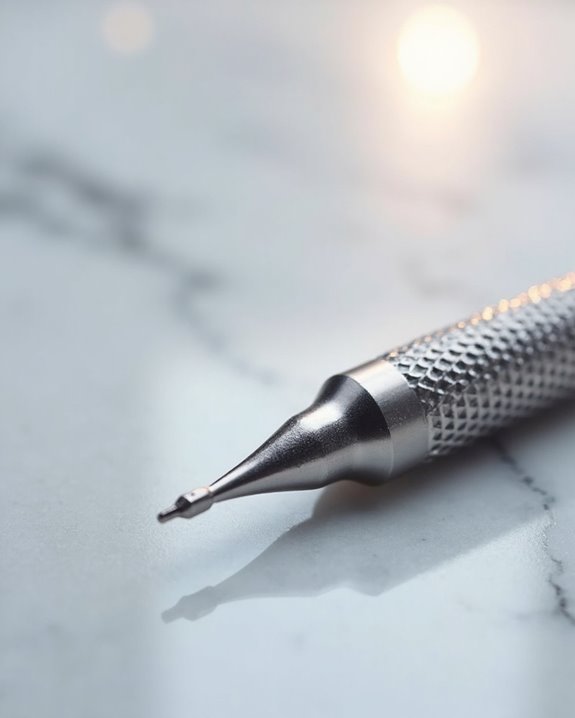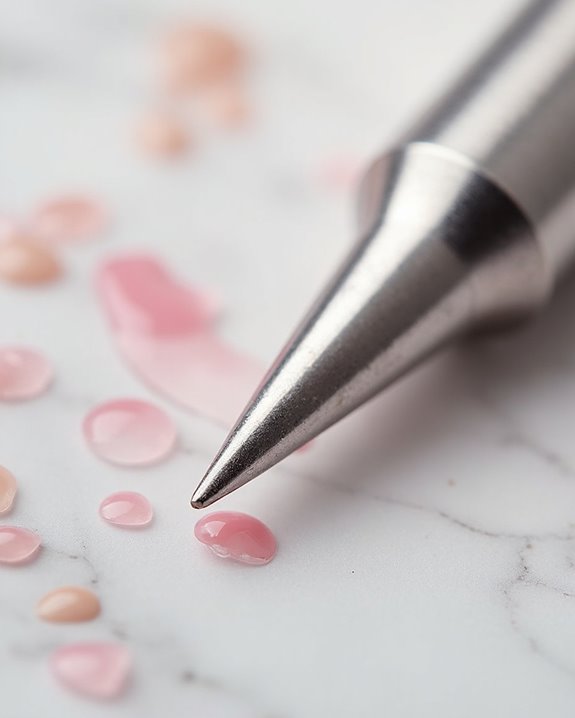For effective cuticle removal, select flame or ball-shaped nail drill bits in soft to medium grit, with flame bits (1.6mm) providing precision and ball bits (2.5mm) offering gentle cleaning. Diamond bits excel for sensitive skin while carbide bits handle thicker cuticles with better heat dissipation. Always operate at lower speeds (under 30,000 RPM) and maintain light pressure to prevent damage. Proper maintenance, including thorough cleaning and disinfection after each use, guarantees best performance and longevity for professional nail care.
Key Takeaways
- Flame drop bits (1.6mm) or ball bits (2.5mm) with soft/medium grit provide precise cuticle lifting without irritation.
- Diamond bits offer gentle abrasion for sensitive clients, while carbide bits provide better heat dissipation for thicker cuticles.
- Red (soft) grit enables gentle tissue removal, blue (medium) offers professional efficiency, and green (coarse) handles stubborn material.
- Always operate at lower speeds initially with light pressure to avoid nail bed damage and client discomfort.
- Clean bits with brush, soap, and warm water after each use, then properly disinfect according to manufacturer instructions.
Choosing the Right Cuticle Bit Shape for Professional Results
When selecting cuticle bits for professional nail services, the shape of the bit greatly influences both technique and results. Nail techs typically recommend the Flame (Drop) shaped bit, particularly the 1.6mm medium grit version, for lifting cuticles due to its precise control and sharper point. For gentle cuticle removal after lifting, the Ball shaped bit in 2.5mm soft grit offers smooth performance without irritating sensitive skin.
The Cone shaped bit, especially the 2.3mm soft grit variant, excels at cleaning and pushing back cuticles efficiently. E-file nail drill bit selection should consider both shape and grit; soft grit (red) bits minimize irritation while achieving professional results. Most experienced technicians prefer middle-sized bits (approximately 2.5mm) in Ball or Flame shapes for versatile cuticle work and improved handling during salon services. For enhanced durability and precision in cuticle work, professionals often opt for tungsten carbide bits that provide superior heat dissipation and minimal vibration.
Diamond vs. Carbide: Which Material Works Best for Cuticle Care
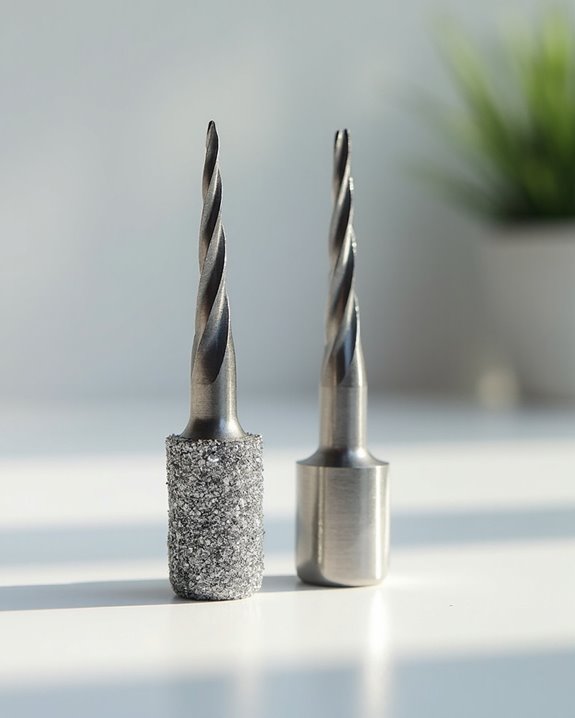
Why do professional nail technicians deliberate so carefully between diamond and carbide bits for cuticle care? The choice impacts efficiency, client comfort, and finished results. Diamond e-file nail drill bits, particularly in medium to soft grits, provide precise control when removing dead skin around cuticles, with flame bit and coarse ball shapes offering versatility for different areas. They excel in gentle abrasion with minimal irritation, making them ideal for sensitive clients.
Carbide bits, constructed from YG6X tungsten carbide, deliver superior heat dissipation and durability for frequent professional use. These bits effectively tackle thicker cuticles without dulling quickly, with large ball varieties efficiently preparing the nail bed. While diamond bits offer finer precision for detailed work, carbide bits provide exceptional longevity and stronger resistance to wear during intensive cuticle removal sessions.
Moreover, many nail drill sets incorporate diamond carbide bits that reduce heat generation and enhance precision for detailed cuticle work.
Understanding Grit Levels for Safe and Effective Cuticle Removal
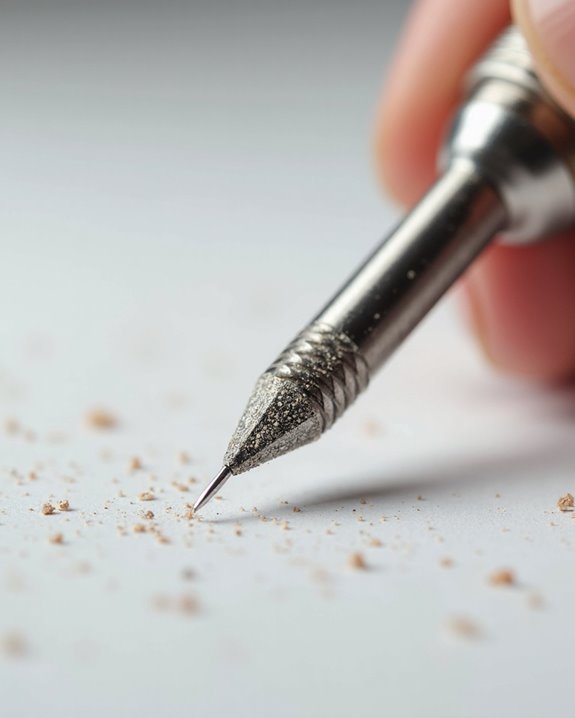
The selection of appropriate grit levels stands as a fundamental aspect of e-file cuticle work, complementing the material choices discussed earlier. Nail drill bits feature a color-coded system—red (soft), blue (medium), and green (coarse)—enabling technicians to match bit aggressiveness to clients’ nails and sensitivity levels.
Soft grit bits provide gentle removal of non-living tissue while minimizing irritation, though they may require additional passes for complete cleaning. Medium grit options deliver balanced efficiency for most clients’ nails, making them the professional standard for cuticle work. Coarse bits, while effective for removing stubborn dry cuticle material, demand cautious application due to increased risk of irritation. Proper bit selection becomes particularly critical considering these tools operate at up to 30,000 RPMs, where improper choices could compromise nail bed health.
For optimal results, diamond bits with finer grits like 180+ are recommended to ensure gentle and effective cuticle removal with minimal skin irritation.
Essential Maintenance Tips to Extend Your Cuticle Bit Lifespan

Properly maintaining cuticle bits represents a critical investment for nail technicians who rely on these precision tools daily. After each use, clean metal carbide bits thoroughly with a small brush, soap, and warm water to remove debris that could compromise their performance and shorten lifespan. When disinfecting, soak drill bits only for the manufacturer-recommended duration, as excessive exposure can erode protective coatings essential for bit longevity.
Complete drying after cleaning prevents rust formation, while proper storing in designated cases shields bits from physical damage and environmental factors. Professionals should immediately discontinue using any dropped tungsten carbide bits, as microscopic fractures can lead to breakage during operation, potentially causing client injury. This thorough maintenance routine—cleaning, disinfecting, drying, and storing—ensures cuticle bits remain in ideal condition, maximizing their functional lifespan and maintaining consistent, professional-quality results.
Mastering Proper Technique for Damage-Free Cuticle Cleaning
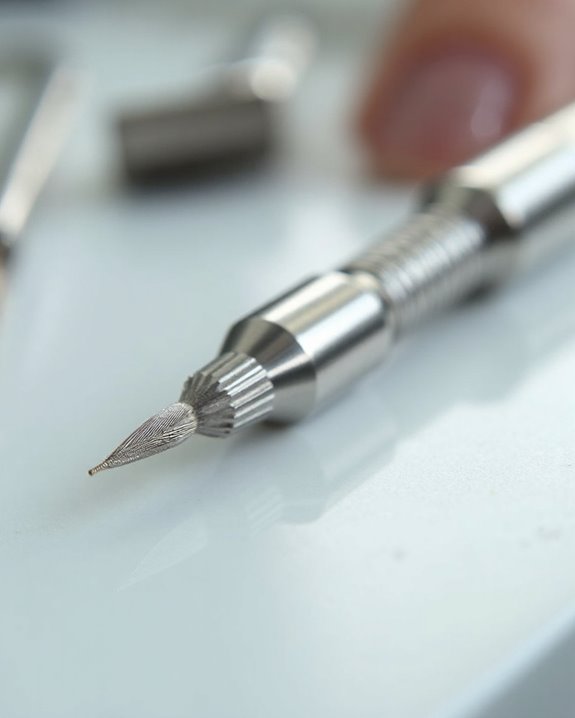
Mastering professional cuticle cleaning techniques requires precision, gentle application, and the right equipment, creating the foundation for damage-free nail services. Technicians should select a soft grit diamond e-file nail drill bit, such as the flame drop style, which effectively lifts cuticles without irritating sensitive skin areas.
For effective cuticle removal, practitioners must begin with lower speeds and apply light pressure, preventing potential damage to the nail bed while achieving precision. A 2.3mm ball-shaped bit offers targeted cleaning during dry manicures, allowing technicians to access difficult areas with minimal discomfort. Many professionals recommend tools with two-way rotation capabilities, accommodating both left and right-handed users while maintaining control. This careful combination of appropriate equipment, adjusted speed, and deliberate technique guarantees healthy nail surfaces and client comfort during professional cuticle maintenance.
Frequently Asked Questions
What Nail Drill Bit Removes Cuticles?
For cuticle removal, professionals use diamond or carbide bits in ball, flame, or barrel shapes with soft grit levels. Size options range from 1.8-4mm across brands like Kiara Sky and MelodySusie at varying price points.
How to Remove Cuticle With Nail Drill?
To remove cuticles with a nail drill, use proper technique tips including low speed control and light pressure levels. Safety precautions are essential for beginners. Avoid common mistakes by maintaining consistent movement and following with appropriate aftercare routine.
What Do Nail Techs Use to Remove Cuticles?
Nail techs utilize cuticle clippers following proper safety measures and tool sterilization. Many combine removal creams with natural oils for client prep. Technique variations exist, with hygiene tips prioritized during different cuticle removal approaches.
What Drill Bit Do I Use to Seal the Cuticle?
Like a painter using a delicate brush for finishing touches, sealing cuticles requires no drill bit at all. Instead, technicians apply sealant options with protective methods after preparation, using manual sealing tools for proper maintenance.

